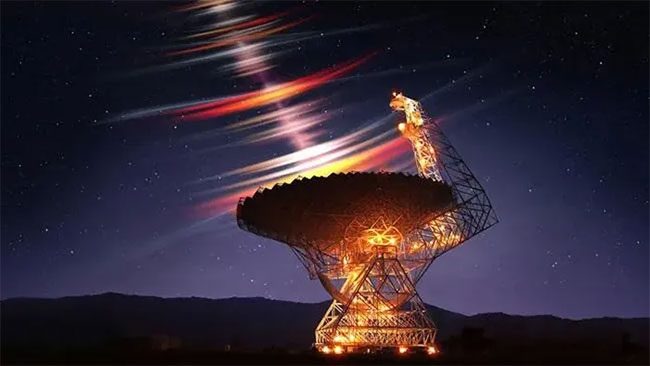For the first time, astronomers have detected ultra-fast radio bursts from a distance of 3 billion light-years.
Astronomers have recently discovered the fastest radio pulses known to come from outside our galaxy hidden within radio telescope data. These findings, published on October 19 in the journal Nature Astronomy, could help researchers uncover the origins of these mysterious flashes.

Simulation of the detection of microsecond bursts. In the foreground is the Green Bank Telescope in the United States, where the research was conducted. The radio waves are displayed as quick-sequence streaks of white, red, and orange. The long red streaks are previously known millisecond bursts. (Photo: Daniëlle Futselaar/artsource.nl).
Fast Radio Bursts (FRBs) are ultra-short electromagnetic radiation pulses with high energy that typically originate from outside our galaxy. Most last from a millisecond to three seconds, during which they emit as much energy as the Sun radiates in a day.
The first FRB was discovered in 2007, and since then, hundreds of other FRBs have been detected. Astronomers remain uncertain about the cause of FRBs. There is evidence suggesting that at least some of the radio pulses originate from magnetars, a type of dense neutron star with an extremely strong magnetic field. Other researchers propose that FRBs could result from neutron star mergers, energetic supernovae, gamma-ray bursts, or even technological signals from extraterrestrial civilizations.
However, astronomers have long suspected that there could be even shorter, faster FRBs that have gone undetected. Mark Snelders, an astronomer at the University of Amsterdam in the Netherlands and the lead author of the study, stated, “In group meetings, we often talked about it. Coincidentally, I discovered that there was a public dataset available for this.”
By analyzing 30 minutes of radio data from the Green Bank Telescope in West Virginia, USA, Snelders and his co-authors identified 8 ultra-fast FRBs originating from a source 3 billion light-years away. Each energy pulse lasts only 10 microseconds or less, making them the fastest ever detected.
Now, scientists have evidence that these ultra-fast FRBs exist. Unfortunately, these flashes may be difficult to detect using this method.
To identify FRBs, researchers must divide each second of radio telescope images into half a million frames. Many datasets from other radio telescopes are not detailed enough to be sliced into such small segments.
Nevertheless, discovering how to find ultra-fast FRBs is a significant step towards understanding their formation.


















































